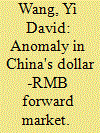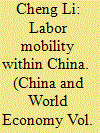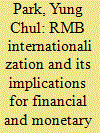|
|
|
Sort Order |
|
|
|
Items / Page
|
|
|
|
|
|
|
| Srl | Item |
| 1 |
ID:
094664


|
|
|
|
|
| Publication |
2010.
|
| Summary/Abstract |
Newly-established data on onshore deliverable US dollar-RMB forwards and the Shanghai Interbank Offered Rate from October 2006 to April 2009 reveal significant violations of covered interest rate parity. This paper explains the cause of this anomaly. Deviations in the forward market are caused by an increase in US dollar-to-RMB conversion restrictions. Given that Chinese monetary authorities want to prevent market participants from taking advantage of the predictable appreciation of the RMB, China's State Administration of Foreign Exchange has to tighten up the control on US dollar-to-RMB conversions. Under the tightened conversion restrictions, similar deviations will resurface in the forward market whenever hot money inflow increases. One way to avoid covered interest rate parity violations in the forward market is to decrease hot money inflow into China by maintaining a stable and credible exchange rate policy.
|
|
|
|
|
|
|
|
|
|
|
|
|
|
|
|
| 2 |
ID:
094661


|
|
|
|
|
| Publication |
2010.
|
| Summary/Abstract |
This article uses multivariate regression and decomposition analyses to assess household income mobility determinants and their contributions to income mobility in rural China from 1989 to 2006. The findings indicate that households with lower initial income level, higher share of wage income, higher educational level of household members, larger number of non-agricultural employed household members and younger heads are more mobile. Moreover, besides initial income, change in the share of wage income, change in the share of non-agricultural employed household members, and change in average year of education of household members are the most important factors that account for income mobility. These findings necessitate more emphasis on policies that promote non-agricultural employment and education to enhance household income mobility in rural China.
|
|
|
|
|
|
|
|
|
|
|
|
|
|
|
|
| 3 |
ID:
094660


|
|
|
|
|
| Publication |
2010.
|
| Summary/Abstract |
Using a large household survey administered across 30 cities in September 2003, we examine the relationship between the degree of economic openness, measured as the sum of imports and exports as a share of GDP, and subjective well-being in urban China. We find that respondents who live in cities with high levels of economic openness report significantly lower levels of subjective well-being ceteris paribus. We offer four explanations for this result; namely, inadequate social protection in the face of globalization, unfulfilled expectations, political dissatisfaction and anomie.
|
|
|
|
|
|
|
|
|
|
|
|
|
|
|
|
| 4 |
ID:
094662


|
|
|
|
|
| Publication |
2010.
|
| Summary/Abstract |
Labor migration is institutionally restricted within China under the hukou system, China's registration system. However, what is the pecuniary impact of labor immobility on interregional wage inequality? To answer this question, we derive a simple wage gap equation including educational attainment, market potential and provincial border indicators. The regressions based on city and sector-level data show that, other things being equal, the wage dispersions within Chinese provincial borders are significantly less pronounced than those among provinces. Such border effects on spatial wage differentials, which have been shown to pervasively exist in all sectors considered in the present paper, reflect the distortions generated by migration controls. Finally, we show that despite the recent hukou reforms aimed at relaxing the restrictions on population movement, border effects appear to persisted over the period 2003-2005
|
|
|
|
|
|
|
|
|
|
|
|
|
|
|
|
| 5 |
ID:
094663


|
|
|
|
|
| Publication |
2010.
|
| Summary/Abstract |
Using conventional and novel techniques, the present paper analyzes the main characteristics of Chinese provincial disparities during the reform period, specifically between 1978 and 2007. After dismissing the presence of spatial dependence, three main results are obtained: first, provincial inequalities have basically followed a "V" trend; second, grouping China into three large regions shows that inequality mainly lies within each region, particularly in coastal areas; and third, the analysis of intra-distribution dynamics reveals that, although there was some significant mobility in provincial relative income, particularly until 1990, the whole period persistence in the ranking of income levels is a major feature. This might provoke some changes in the policy approach to dealing with spatial disparities.
|
|
|
|
|
|
|
|
|
|
|
|
|
|
|
|
| 6 |
ID:
094659


|
|
|
|
|
| Publication |
2010.
|
| Summary/Abstract |
This paper emphasizes the importance of the denomination of financial assets rather than trade invoicing as a long-term determinant of an international currency. China needs to liberalize and open its financial system and make the RMB fully convertible, and to adopt a more flexible exchange rate system to speed up its currency internationalization, for which China could follow either a global or regional approach. The global approach is a riskier and more unpredictable strategy because it would demand a scope and timeframe of financial liberalization that is likely to be beyond China's institutional capacity over the coming decade. There are two options that could be taken in following the regional approach. One is creating an ASEAN+New 3 (the Chinese Mainland, Hong Kong, and Taiwan) RMB bloc and the other is liberalizing China's financial industries and internationalizing the RMB by playing a leading role in East Asia's economic integration within the framework of ASEAN+3. This paper concludes that the latter is a more realistic and effective approach for China.
|
|
|
|
|
|
|
|
|
|
|
|
|
|
|
|
|
|
|
|
|